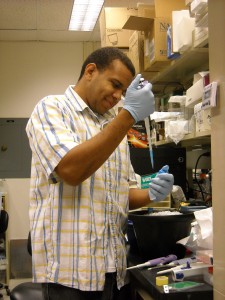Jillian Bannister
 Analysis of Shi Wei Bai du Tang and Federal Oversight of Dietary Supplements
Analysis of Shi Wei Bai du Tang and Federal Oversight of Dietary Supplements
It is estimated that $3.87 billion is spent annually on herbal products, botanicals, nutraceuticals and dietary supplements (Newton et al., 2000). Dietary supplements are synthetic or extracted vitamins, minerals, fatty and amino acids, or herbs intended to supplement the lack of these various things in an individual’s diet. Currently dietary supplements do not require FDA approval to be sold in the United States. Can all dietary supplements be safe for consumption with little federal oversight and the ultimate safety of the product being determined by the manufacturers? We hypothesized that ShiWei Bai du Tang, a Chinese herbal supplement would contain compounds whose effects would potentially be harmful to consumers who were not aware of the contents. Four extracts were prepared with the herbal supplement and gas chromatography-tandem mass spectrometry was performed to identify compounds in the extracts. This analysis revealed many compounds, but 2 in particular were of interest; osthole and falcarinol. Osthole and falcarinol can potentially have adverse effects in individuals with specific health issues such as patients taking blood thinners. It is our assertion that stricter government regulations are necessary in the production, distribution and labeling of dietary supplements for the sake and safety of the consumer.
Kevin McKenzie
 The Investigation of Follicle Stimulating Hormone Receptor in Plasma Membrane Microdomain Residency
The Investigation of Follicle Stimulating Hormone Receptor in Plasma Membrane Microdomain Residency
The human follicle stimulating hormone receptor (hFSHR) is a G protein-coupled receptor involved in reproduction in both males and females. hFSHR is involved in complex networks of signaling molecules beyond the G proteins and understanding the ability of the receptor to participate in many signaling pathways is of significant interest for those looking to modulate receptor function. One possibility is that microdomains in the plasma membrane, such as lipid rafts, play an important role in signal transduction. The aim of this study was to determine the role of plasma membrane microdomains in hFSHR function. To analyze this, lipid rafts were disrupted using the cholesterol withdrawing agent methyl- -cylcodextrin (M CD) and hFSH activation of MAP kinase pathways was investigated. Removal of membrane cholesterol caused the loss of hFSH induced p38-MAP kinase activation but did not alter p42/44 MAP kinase activation. To investigate further the residency of hFSHR in lipid rafts, co-immunoprecipitation experiments were performed to determine if caveolin-1 interacted with hFSHR. Caveolin-1 was overexpressed in cells stably transfected with hFSHR. A monoclonal antibodyagainst hFSHR was used to immunoprecipitate the receptor and caveolin-1 was shown to co-immunoprecipitate. Current studies aim to determine the physiological role of this interaction.
Amy Nestlerode
 Role of Lipid Rafts in Follicle Stimulating Hormone Signal Transduction
Role of Lipid Rafts in Follicle Stimulating Hormone Signal Transduction
Follicle stimulating hormone (FSH) is an important hormone in both male and female reproduction. By studying the mechanisms of action of this hormone, it is then possible to come up with ways to disrupt these pathways, leading to advances in birth control. Specifically, FSH stimulates the ovarian follicles to grow in females and it stimulates spermatogenesis in males. This hormone transmits its signal by binding to G protein coupled receptors on the cell surface. In the cell membrane, there are specific domains called lipid rafts. These domains are often associated with being a central area for signal transduction in cells. The main goal of our research was to determine if the FSH receptor resides in a lipid raft. One way to identify lipid rafts is by the presence of a membrane sphingolipid called ganglioside GM1. After staining cells with an antibody that recognizes the FSH receptor and an antibody that stains for GM1 we used fluorescence and confocal microscopy to determine if the two signals coincided. The two signals showed limited colocalization
using this approach. This is consistent with our model which suggests that only some FSHR is in lipid rafts, and only some lipid rafts contain FSHR.
Christian Sikora
 Effects on signal transduction of S80A and S80E isoforms of caveolin-1 and its interaction with Human Follicle Stimulating Hormone
Effects on signal transduction of S80A and S80E isoforms of caveolin-1 and its interaction with Human Follicle Stimulating Hormone
Follicle Stimulating Hormone Receptor is a G protein- coupled receptor that is central to mammalian reproduction. Understanding how the receptor functions on the molecular level is an important goal in reproductive endocrinology. One area of interest is the role of cell-surface microdomains in maintaining FSHR function. To gain a better insight into the relationship between membrane microdomains and FSHR, we investigated the relationship between caveolin (a marker for a specific type of membrane microdomain) and hFSHR. We investigated where the interaction of cav-1 and FSHR occurs, and then whether the interaction of caveolin-1 (cav-1) and FSHR is required for normal signal transduction. To determine the location of interaction between cav-1 and FSHR,
mutant isoforms of cav-1 were expressed as myc-tagged isoforms in HEK293-hFSHR cells. This mutant Cav-1 becomes stuck in the endoplasmic reticulum with cav-2. The resulting cells were lysed and immunoprecipitated to determine whether FSHR interacted with caveolin-S80E. This interaction, if observed, implies that the caveolin-hFSHR interaction must occur in the endoplasmic reticulum. If the interaction is not observed, then the interaction must occur at a later point in the proteins’ life. Future studies will investigate the role of the cav-1-hFSHR interaction in normal hFSHR signaling.
Tatum Weishaupt
 Academic Stress in First Year Students
Academic Stress in First Year Students
The transition to college is the beginning of unfamiliar experiences, both social and academic, which may beget personal anxiety and stress for the student. The stressors encountered in the period of adjustment may lead to adverse effects on mental and physical health, depending largely upon the coping mechanisms possessed by the individual. The hypothalamic-pituitary-adrenal (HPA) axis is the biological pathway activated as a result of stressors, leading to increased cortisol levels. The current research was undertaken to reveal whether a student’s self-reported stress score on the State-Trait Anxiety Inventory (STAI) and the Beck Depression Inventory II (BDI-II) would correlate with measured salivary cortisol. It was proposed that as a greater level of stress was identified, cortisol levels would increase and that specific points in the term would elicit greater stress. First year students provided saliva samples and completed surveys in weeks two, five, eight, and ten of the academic term. A correlation was found between STAI and BDI scores and the salivary cortisol in a sample population. This data suggested that as perceived anxiety and depression increase, cortisol levels increase and may provide a new tool for helping understand the stressors associated with the transition to college.
Honorary Members:
- Halley Vora- Advisor: Dr. Martin Farber
- Sarah Westen- Advisor: Prof. Cay Anderson-Hanley

You must be logged in to post a comment.